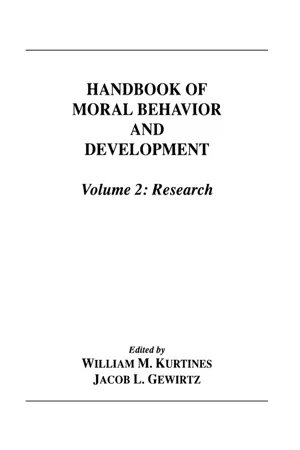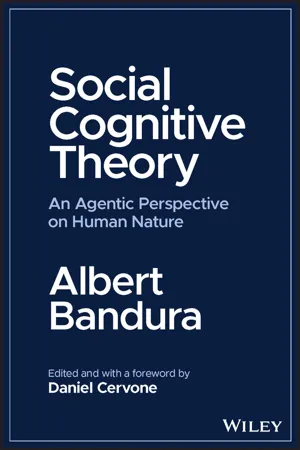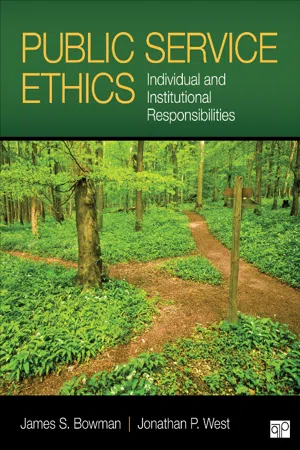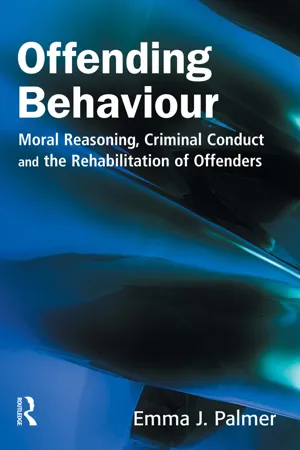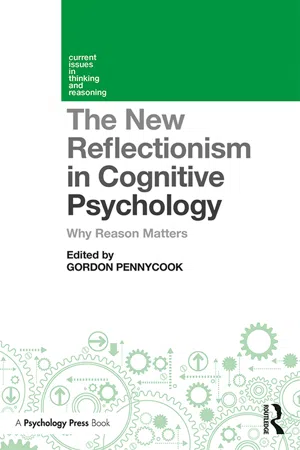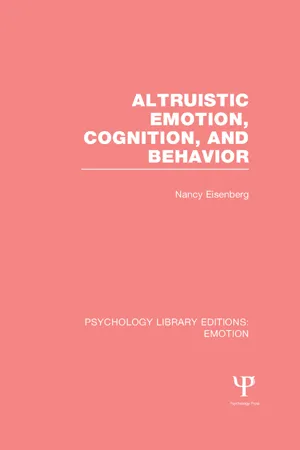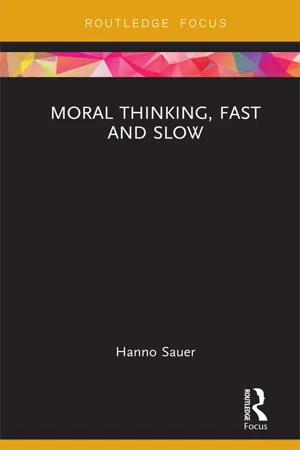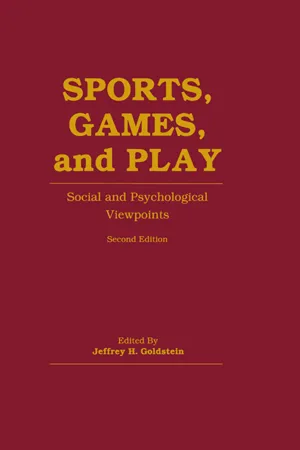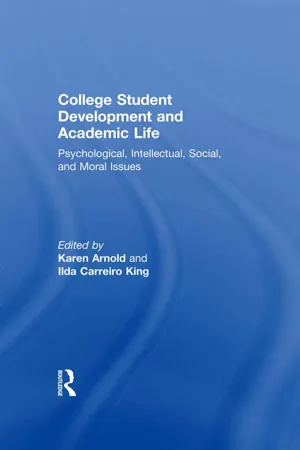Psychology
Level of Moral Reasoning and Cognitive Distortions
Level of moral reasoning refers to an individual's ability to make ethical decisions based on their cognitive development. Cognitive distortions are irrational thoughts or beliefs that can lead to negative emotions and behaviors. In psychology, understanding an individual's level of moral reasoning and identifying cognitive distortions can help in assessing and addressing their ethical decision-making and mental well-being.
Written by Perlego with AI-assistance
Related key terms
10 Key excerpts on "Level of Moral Reasoning and Cognitive Distortions"
- eBook - ePub
- David Wasieleski, James Weber, David M. Wasieleski, James Weber(Authors)
- 2019(Publication Date)
- Emerald Publishing Limited(Publisher)
Rest (1979) followed the work of Kohlberg and is one of the most prominent scholars associated with the study of moral reasoning.Like Kohlberg, Rest used Rawls’ principles of justice as the basis for the normative foundation of his model, but he developed a slightly different conceptualization of the stage progression for an individual’s cognitive moral development. As a result, he developed a widely used pencil-and-paper instrument, called the DIT, to measure the moral reasoning of individuals (Rest, 1979 ). Elm and Weber (1994) describe the theoretical foundation and stages of Kohlberg and Rest’s models:The critical perspective underlying Kohlberg’s model is the identification of the reasons given why certain actions are perceived as morally just or preferred. As the subjects express distinctly different moral rationales, these rationales are captured in the different stages of moral development. Kohlbergian research identifies three levels of moral development: preconventional, conventional, and postconventional. Each level is comprised of two stages of reasoning. The second stage represents a more advanced and organized form of the first stage within each level. The three levels are briefly summarized below (for a more complete description of Kohlberg’s stages of moral development see Colby & Kohlberg, 1987 , particularly pp. 18–19)Preconventional LevelAt this primary level, the individual understands notions of “right” and “wrong” in terms of consequences of action (punishment, rewards, and exchange of favors) or the imposition of authoritarian power. At Stage 1 (Punishment and Obedience Orientation), the physical consequences of an action determine its goodness or badness. Avoidance of punishment and unquestioning deference to power are the key values. Right action is defined in Stage 2 (Instrumental Relativist Orientation) as that which satisfies one’s own needs. Elements of fairness and equal sharing are interpreted in terms of the physical or pragmatic consequences upon the decision-maker.Conventional LevelAs an individual progresses to the conventional level, the maintenance of expectations imposed upon the decision-maker by the family, group, or nation is perceived as valuable. Stage 3 (“Good Boy-Nice Girl” Orientation) emphasizes behavior that will please or help others, thus gaining approval from others for the decision-maker. At this stage, there is a significant emphasis upon conformity to stereotypical images of majority or acceptable behavior. At Stage 4 (Law and Order Orientation), the individual takes the perspective of a generalized member of society. This perspective emphasizes adherence to a consistent set of societal, legal, or religious procedures that are applied impartially to all members of society.Postconventional LevelAs the individual exhibits a postconventional level of moral maturity, there is a clear effort to define moral values and principles apart from various authoritarian figures and bodies. Generally with utilitarian overtones, Stage 5 (Social-contract Legalistic Orientation) defines right action in terms of general individual rights and socially accepted standards. Rather than rigidly maintaining laws (reflective of Stage 4, Law and Order Orientation), Stage 5 emphasizes the possibility of changing law based upon rational considerations of social unity. At Stage 6 (Universal Ethical Principle Orientation), right is defined by the decision-maker’s conscience in accord with self-chosen ethical principles appealing to logical comprehensiveness, universality, and consistency. (It should be noted that as the stages are applied in a Kohlbergian empirical assessment of individuals, Stage 5 and Stage 6 are generally combined into a Stage 5 designation.) (Elm & Weber, 1994 - eBook - ePub
Handbook of Moral Behavior and Development
Volume 2: Research
- William M. Kurtines, Jacob Gewirtz, Jacob L. Lamb(Authors)
- 2014(Publication Date)
- Psychology Press(Publisher)
A brief synopsis of Kohlberg’s (1981, 1984) theory may be helpful at this point. Kohlberg argues that it is appropriate and useful to characterize moral reasoning in terms of a strict stage model. This model holds that moral reasoning stages represent holistic structures that are in an invariant, universal sequence and that constitute a hierarchy (Walker, 1988). In other words, individuals should be consistent in stage of reasoning across contents and contexts; their development should be irreversibly progressive, one stage at a time; and they should recognize the increased moral adequacy of successive stages of moral reasoning. Kohlberg has postulated six stages in the development of moral reasoning which are amply described elsewhere and need not be duplicated here. Kohlberg claimed empirical support for the first five stages but regarded Stage 6 primarily as a theoretical construct because of its absence in his longitudinal data (Colby, Kohlberg, Gibbs, & Lieberman, 1983).Kohlberg (1976) claimed that the order of development through the stages is invariant, but predicted variability in rate and eventual end-point of development. There are two main determinants of rate of moral development: (a) attainment of prerequisite levels of cognitive and perspective-taking development (i.e., moral reasoning has a basis in cognition), and (b) exposure to appropriate sociomoral experiences (i.e., moral reasoning also has a basis in social interactions). Claims regarding the former determinant are derived from the cognitive-developmental assumption of structural parallelism which implies that isomorphic processes are involved in parallel stages in different domains of cognition. This claim has been supported by studies that indicate that attainment of a moral stage requires the prior or concomitant attainment of the parallel cognitive and perspective-taking stages (Walker, 1988).Level of moral development is influenced not only by cognitive prerequisites but also by exposure to sociomoral experiences (Kohlberg, 1973, 1976). Claims regarding this determinant are derived from the cognitive-developmental assumption that disequilibrium (or cognitive conflict) is the cognitive motivational mechanism that induces development (Walker, 1988). Thus, the experiences that promote moral development are often emotional, personal experiences involving responsibility and decision making—ones that entail cognitive conflict. The essential feature of these social experiences for moral development is the provision of role-taking opportunities in conflict situations. These experiences arise both through interpersonal relationships with family and friends and through real participation in the economic, political, and legal institutions of society through education, occupation, and citizenship activities. A number of studies have provided support for the notion that social experiences relate to moral development. For example, moderately strong relations have been found between moral development and level of education (Bielby & Papalia, 1975; Boldizar, Wilson, & Deemer, 1989; Buck, Walsh, & Rothman, 1981; Colby et al., 1983; Edwards, 1975; Pratt, Golding, & Hunter, 1983; Walker, 1986a) and between moral development and occupational status (Boldizar et al., 1989; Buck et al., 1981; Edwards, 1975; Walker, 1986a). Other social experiences that have been found to relate positively to moral development include: political and social activity (Fontana & Noel, 1973; Haan, Smith, & Block, 1968; Keasey, 1971), living independently rather than with parents or in residences (Edwards, 1975; Haan et al., 1968), joint household decision-making (Walker, 1986a), and family and peer discussions (Berkowitz, Gibbs, & Broughton, 1980; Buck et al., 1981; Haan, 1985; Holstein, 1972; Parikh, 1980; Powers, 1983, 1988). - eBook - ePub
Social Cognitive Theory
An Agentic Perspective on Human Nature
- Albert Bandura, Daniel Cervone(Authors)
- 2023(Publication Date)
- Wiley(Publisher)
Stage theorists assume that different types of moral thinking develop in an invariant sequence. Each stage is said to feature a distinctive, uniform way of thinking. Piagetian theory (1948) favors a developmental sequence progressing from moral realism, in which rules are seen as unchangeable and conduct is judged in terms of damage done, to relativistic morality in which conduct is judged primarily by the performer's intentions. In the latter stage, well‐intentioned acts that produce much harm are viewed as less reprehensible than ill‐intentioned acts that cause little harm. Moral absolutism stems from unquestioning acceptance of adult prescripts and the egocentric outlook of young children; moral relativism develops from increasing personal experiences and reciprocal relationships with peers.Following Piaget's lead, Kohlberg developed an expanded cognitive structural theory of morality that revitalized and altered the direction of the field. Kohlberg (1969, 1976 ) postulated a six‐stage sequential typology of moral rules, beginning with punishment‐based obedience, evolving through opportunistic self‐interest, approval‐seeking conformity, respect for authority, contractual legalistic observance, and culminating in principled morality based on standards of justice. Changes in the standards of moral reasoning are produced by cognitive conflict arising from exposure to higher levels of moral reasoning. [Specifically, in Kohlbergian theory, conflicts induce a “cognitive disequilibrium” that promotes movement toward a higher level of moral thought (see, e.g., Haan, 1985 ).]Because the six Kohlbergian stages are said to be a fixed developmental sequence, individuals cannot acquire a given form of moral reasoning without first acquiring the preceding modes in order. Regarding social influences, it is presumed that exposures to forms of moral reasoning that are too discrepant from one's dominant stage have little impact because they are insufficiently understood to activate any changes. Judgmental standards of lesser complexity are similarly rejected because they have already been displaced in attaining more advanced forms of thinking. Views that diverge moderately above one's stage presumably create the necessary cognitive perturbations, which are reduced by adopting the higher stage of moral reasoning. - eBook - ePub
Public Service Ethics
Individual and Institutional Responsibilities
- James S. Bowman, Jonathan P. West(Authors)
- 2014(Publication Date)
- CQ Press(Publisher)
Kohlberg built on the work of Jean Piaget, developing an empirically based moral development theory premised solely on moral reasoning. For Kohlberg, the levels at which people operate when confronting moral issues vary as they pass through different phases of their lives. Children, adolescents, and some adults dominate the preconventional level, while most of the population operates at the conventional level, and a much smaller percentage reach the postconventional level. Upward movement from lower to higher stages in the hierarchy can occur through a maturation process that leads to a more sophisticated and complex understanding of ethical problems and solutions.Kohlberg posed case dilemmas to his research subjects, asking them what they would do in such situations. However, he was less concerned with their answers than in their response to a second question: “Why?” He was interested in the moral reasoning subjects used in addressing the issue. Kohlberg’s question was why do people behave in certain ways at each level of moral development? A well-known case used by Kohlberg involved a man, Heinz, who had to decide whether to steal a drug he couldn’t afford but that would save the life of his ailing wife. Kohlberg observed variation in the way people reacted to, interpreted, and dealt with Heinz’s and other dilemmas. Kohlberg’s theory of cognitive moral development grew out of the recorded responses to such hypotheticals posed to different respondent groups. Analysis of the contemporary hypothetical case in Case Study 4.1 illustrates the thought processes using Kohlberg’s three-level, six-stage schema that might be provoked by an ethically challenging situation confronting military Private X.Twenty years in the making, Kohlberg’s theory presumes that careful moral reasoning can—and should—affect one’s ethical perspective, and that moral judgment has cognitive features. His theory, while extraordinarily influential, has been challenged on many fronts. Among the criticisms are the narrow focus on moral judgment, inattention to issues of conflict of interest or confidentiality, insufficient evidence of postconventional thinking, overemphasis on macro and underemphasis on micro morality, a hard “staircase” approach to stage development, undue reliance on verbal responses, an implication that higher stages are morally preferable to lower stages, the restriction of samples to males, and its inclusion of certain ethical approaches while excluding others (Rest & Narrvaez, 1994; Rest et al., 1999; Swisher, Rizzo, & Marley, 2005; Velasquez, 1998). Other researchers refer to “schemas” and “orientations” rather than stages in describing moral development. - eBook - ePub
- Emma J Palmer(Author)
- 2013(Publication Date)
- Willan(Publisher)
Moral reasoning is egocentric, with the person’s own needs being of greatest importance. Reasoning is based on the perceived balance of rewards and punishment. Level 2: Conventional reasoning Stage 3 Moral reasoning is determined by other people’s needs, with personal relationships assuming importance. Stage 4 Moral reasoning is based on maintaining society’s rules and laws in order to keep society in order. Level 3: Postconventional reasoning Stage 5 Moral reasoning is underpinned by an understanding that society’s laws are a contract between the individual and society. However, under certain circumstances these laws can be broken. Stage 6 Moral reasoning is determined by self-chosen ethical principles that are consistent over time and situations, and these may over-rule society’s laws if they come into conflict with each other.At the conventional level, reasoning moves on to reflect an understanding of society’s conventions and the need to maintain them. The predominant social perspective at Stage 3 is of the individual existing within a network of relationships with other people (e.g. family and friends). Behaviour is therefore justified in terms of maintaining these relationships, with reference made to the needs of these people, and the shared expectations and mutual trust between people within these relationships. Stage 4 reasoning moves beyond the individual’s per sonal relationships, to a social perspective based on the wider social system in which people live. Moral reasoning becomes concerned with justifying behaviour in terms of ensuring that the social system is fair and just to all people within it.Finally, the postconventional level (Stages 5 and 6) represents an understanding that behaviour within a society is based on underlying moral principles. Individuals reasoning at this level have a social perspective that is based on their own set of coherent moral and ethical principles. If these principles come into conflict with those of society, they are likely to overrule those of society to ensure consistency within the individual’s behaviour. - eBook - ePub
The New Reflectionism in Cognitive Psychology
Why Reason Matters
- Gordon Pennycook, Gordon Pennycook(Authors)
- 2018(Publication Date)
- Routledge(Publisher)
Such trait-level research is obviously important, but more experimental research would strengthen the claim that reasoning plays a causal role in producing moral judgments. Second, research is needed that examines what specific aspects of what we have called “good reasoning” reliably affect moral judgment. For simplicity’s sake, we have treated many different psychological constructs (e.g., cognitive reflectivity, IQ, cognitive style, etc.) as measures of “good reasoning.” But, in the wider literature, these are treated as at least somewhat distinct, which raises interesting questions about which aspects of cognition are related to which aspects of moral judgment. The finding by Pennycook et al. (2014) that cognitive reflectivity, but not cognitive ability, uniquely predicts condemnation of harmless purity offenses is a promising first step in this direction. Our aim in this chapter has been to review the often disparate findings on the role of reasoning in moral judgment and to provide a coherent theoretical account of these findings. We have therefore deliberately not discussed the relationship between reasoning and moral behavior. At the present time, the literature that we have reviewed here and the literature on prosociality and cooperation have had surprisingly little influence on one another, but we see the potential for fruitful cross-pollination between them. In particular, we think that the Social Heuristics Hypothesis (Rand, 2016; Rand et al., 2014) has much to offer the study of moral judgment. On this view, cooperation with others is generally rewarded, and therefore becomes the default, intuitive response, while self-interested non-cooperative behavior relies on deliberate thinking. As we mentioned above (see Note 1), we think that moral judgments can be “intuitive” (i.e., fast and automatic) while still being rooted in reasoning - Nancy Eisenberg(Author)
- 2014(Publication Date)
- Psychology Press(Publisher)
The altruism which in my view underlies ethics is not to be confused with generalized affection for the human race. It is not a feeling…. Without question people may be motivated by benevolence, sympathy, love, redirected self-interest, and various other influences, on some of the occasions on which they pursue the interests of others, but that there is also something else, a motivation available when none of those are, and also operative when they are present, which has genuinely the status of a rational requirement on human conduct. There is in other words such a thing as pure altruism (though it may never occurs in isolation from all other motives). It is the direct influence of one person’s interest on the actions of another, simply because in itself the interest of the former provides the latter with a reason to act. If any further internal factor can be said to interact with the external circumstances in such a case, it will be not a desire or an inclination but the structure represented by such a system of reasons [pp. 3, 80].Clearly, according to Nagel, the involvement of affect in the helping process taints its purity.Lawrence Kohlberg, who has developed a psychological model of moral development based on cognitive-developmental theory (this theory will be discussed in Chapters 7 and 9 ), was clearly influenced by the writings of philosophers such as Kant. Kohlberg delineated a sequence of stages of moral reasoning that he views as the basis of moral development (Kohlberg, 1969, 1971, 1976, 1981). These stages are described as being invariant in sequence, universal to all persons, and as having a hierarchical structure (i.e., each stage is more advanced than the previous). Moreover, each stage is purportedly a mode of thinking or problem solving that is qualitatively distinct from previous stages. Advancement through the stages is a function of cognitive development as well as of life experiences that stimulate the growth of social cognition. Although Kohlberg does not claim that his stages are strictly cognitive, they are viewed as mediated by changes in reasoning.What is being asserted, then, is not that moral judgment stages are cognitive but that the existence of moral stages implies that moral development has a basic structural component. While motives and affects are involved in moral development, the development of these motives and affects is largely mediated by changes in thought patterns… Moral judgment stages or sequences are to be described in cognitive structural terms even in regard to “affective” aspects of moral judgment, like guilt, empathy, etc. [1969, p. 390].- eBook - ePub
- Hanno Sauer(Author)
- 2018(Publication Date)
- Routledge(Publisher)
Moral cognition is based, not on belief or desire, but on automatic, algorithmic, and reflective cognition. The functional profiles of these states – mind-to-world or world-to-mind direction of fit – are all over the place. Intuitions have propositional content, but are also affectively valenced; critical thinking dispositions define epistemic goals, but are fundamentally in the business of getting at the truth; moral mindware consists of crystallized knowledge structures that implement practical cognitive strategies. From this perspective, the cognitive/non-cognitive distinction seems crude at best and confused at worst. Some of it is affective, some of it is automatic, some of it is conscious. It’s all cognition. Moral judgment is a largely intuitive enterprise, but that doesn’t make it non-rational, or place it outside of the space of reasons. It becomes part of the space of reasons because of the way moral intuitions are monitored by reflective capacities, overridden by conscious thinking, and shaped by moral mindware. This cooperation of intuition, conscious processing and critical thinking may seem haphazard and kludgy at times, but it’s what we have to make do with. It is how finite beings reason. Notes 1 Indeed, Shea and Frith (2016) posit “type zero” as a fifth type. 2 On the possibility of vindicating arguments, see Sauer 2018, forthcoming. Like debunking arguments, vindicating arguments do not provide direct support for the truth of their conclusions. Debunking arguments are undercutting defeaters; likewise, vindicating arguments merely show that, before looking at its content, a given judgment has comparatively better epistemic credentials - eBook - ePub
Sports, Games, and Play
Social and Psychological Viewpoints
- Jeffrey H. Goldstein(Author)
- 2012(Publication Date)
- Psychology Press(Publisher)
Kohlberg’s (1981, 1984) work is well known and is only briefly summarized in this chapter. His ground-breaking theory of moral development is rooted in the cognitive developmental approach to psychology most prominently associated with Piaget. Accordingly, the concept of universal stages occupies a central place in Kohlberg’s work. Within the Piagetian framework, stage progression is hypothesized to reflect an interactive process between the innate tendency of the developing child to actively organize information and an environment that demands accommodation to its features.Basic ConceptsFour key concepts can help us understand Kohlberg’s theory of moral development: moral issues, orientations, principles, and stages. Kohlberg believes that certain moral issues or values are universally recognized as important. These issues include the values of life, property, truthfulness, civil liberties, conscience, rules and laws, affiliation, authority, contract, and trust (Kohlberg, 1976). The content of moral thinking is about these moral values. Sometimes, however, one person’s claim on a particular value may come into conflict with those of others. Kohlberg (1969) wrote, “the area of conflicting claims of selves is the area of morality.” Thus, for example, if a player is asked by a coach to violate a rule, the coach’s claim of authority may conflict with the player’s claim to rule obedience.To help clarify what is involved in moral thinking, Kohlberg turns to what he calls the four universal moral orientations (Kohlberg, 1976). A moral orientation is a general approach for dealing with moral conflicts. Each moral orientation focuses on a critical element to help decide right and wrong. The first, the normative order orientation, focuses on prescribed rules and roles; decision making is guided by a consideration of rules. The consequence orientation focuses on the impact of various actions on the welfare of others and/or the self; decision making is guided by beliefs about the outcome of various behavioral options. The justice orientation focuses on the relations of liberty, equality, reciprocity, and contract between people. In decision making, this orientation is characterized by a concern for impartiality and fairness. Finally, the ideal-self - eBook - ePub
College Student Development and Academic Life
Psychological, Intellectual, Social and Moral Issues
- Philip G. Altbach, Karen Arnold, Ilda Carreiro King(Authors)
- 2014(Publication Date)
- Routledge(Publisher)
We call this position “reflective relativism” or “class-biased universalism.” The latter reference is to persons who recognize higher law principles and claims, but in applying them fall into a pattern of distorting the interests and well-being of other persons and groups by assimilating them to their own, resulting in a kind of moral pseudo-stage 5. This latter point indicates that moral stage 5, as an intellectual or cognitive construct, is possible at faith stage 4. But a moral stage 5 which integrates and forms a person's consistent moral action appears to be unlikely apart from a faith stage 5. Faith stage 5, we believe, can exhibit either moral stages 5 or 6 with authentic comprehension. Our data on faith stage 5 is far more limited than our studies of faith stages 3, 3(4), 4(3), and 4; therefore, our claims about the relations between faith and moral stages 5 and 6 are more speculative than our claims about the middle stages. Considerably more detailed data, testing the issue of precedence and cause of development between moral judgment and faith stages, are found in the doctoral dissertation completed by Eugene J. Mischey at the University of Toronto, in 1976. 28 “Faith Development and Its Relationship to Moral Reasoning and Identity Status in Young Adults” is the title of this study. Mischey used the Fowler faith development interview and scoring procedures. He tested for identity status with Marcia's (1966) interview format. In addition he administered Kohlberg's moral dilemmas in a written form, Faulkner and Dejong's Religiosity Scale, and Rotter's Internal-External Locus of Control Scale. His subjects were 30 young adults between the ages of 20 and 35. While we must observe some caution about the adequacy of relying upon pencil and paper measurement of response to Kohlberg's moral dilemmas, Mischey's findings about the relations between faith and moral stages of his respondents are quite interesting
Index pages curate the most relevant extracts from our library of academic textbooks. They’ve been created using an in-house natural language model (NLM), each adding context and meaning to key research topics.

